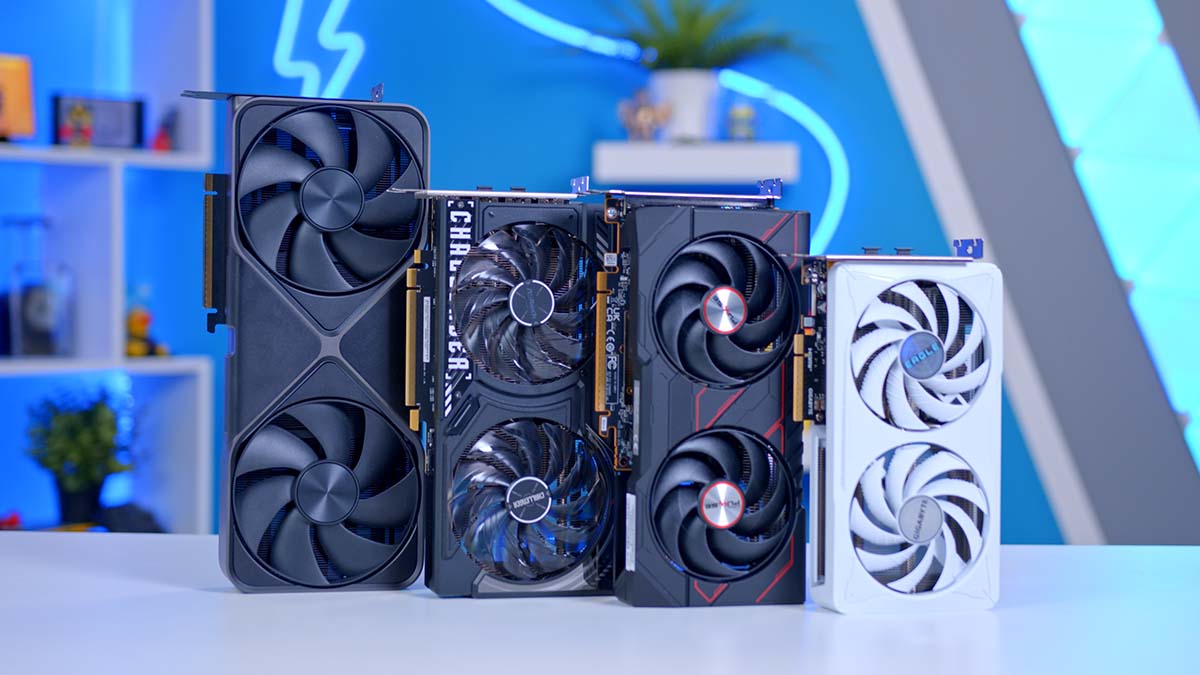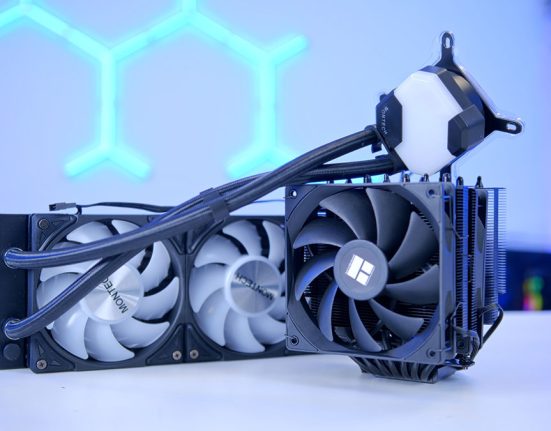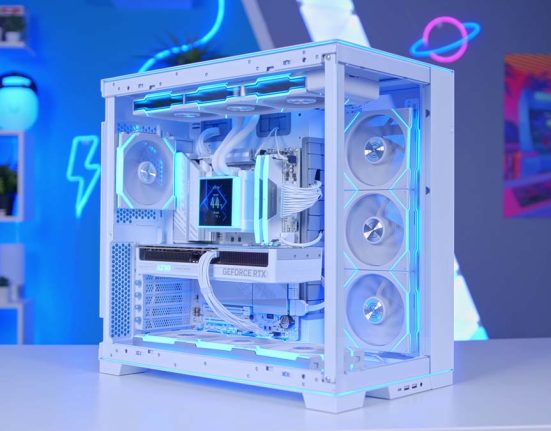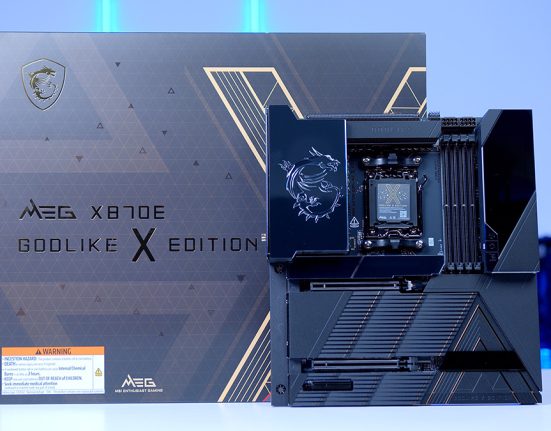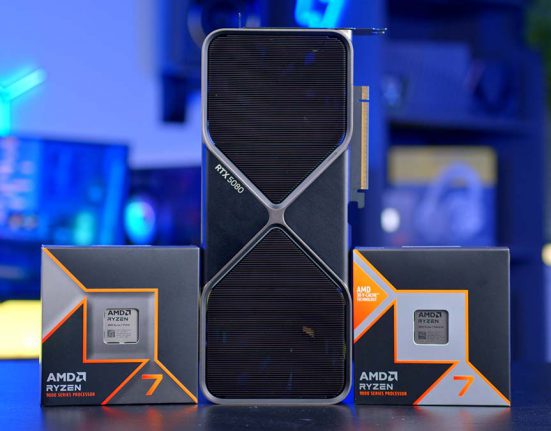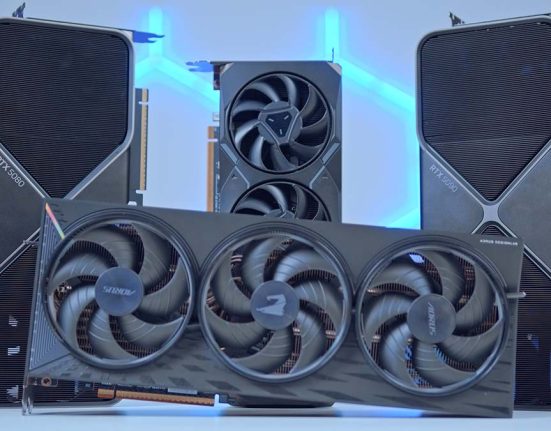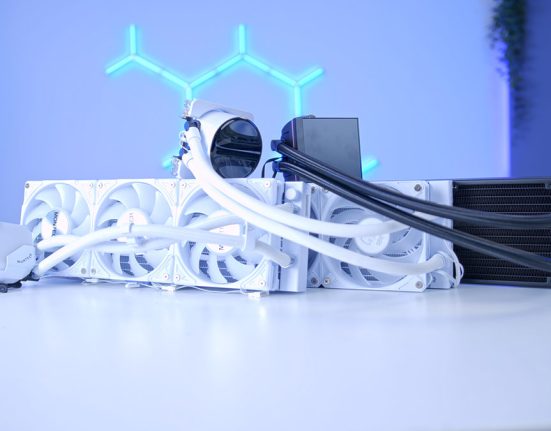The graphics card market in 2025 is incredibly competitive. NVIDIA, AMD, and Intel are constantly battling to beat one another in pricing and performance by offering new GPUs or slashing existing prices down to a more affordable level. With so many new cards hitting the shelves, purchasing the right option for your PC build can be confusing. So, how do you determine which graphics cards are the best to buy out of the myriad of GPUs available?
Here at GeekaWhat, we’re well-equipped to recommend the best options for a range of budgets, which is precisely what we’ll be doing here. Harry Coleman and James Cousins from our team are experts in GPU benchmarking and testing, having benchmarked every card released by AMD, NVIDIA, and Intel in the last few years.
Our testing includes some of the biggest games out there, from popular esports titles like Apex Legends and Fortnite to demanding AAA titles like Cyberpunk 2077 and Alan Wake II, giving us 1000s of data points for comparison. You can learn more about how we test graphics cards and view detailed gaming benchmarks for all of the cards below.
Best Graphics Cards Under $250
1. Intel Arc B570

The first graphics card in this roundup is Intel’s ARC B570. This GPU is part of the second generation of ARC cards, which were received with far less criticism than the first-generation cards. The reasons why we’ve put this card in first place are twofold. The first is its price. GPUs have continued to increase in price over the years, and the ARC B570 is one of the cheapest graphics cards on the market, with an MSRP of $220, beating out the AMD Radeon RX 9060 XT and NVIDIA RTX 5050.
The second reason is its performance. The ARC B570 has received a massive performance boost compared to its predecessors. Gone are the driver problems we saw on ARC A-series cards. The ARC B570 is primarily a 1080p graphics card, but our testing offered solid metrics across 1440p, including over 60FPS in Cyberpunk 2077 and similar performance in Hogwarts Legacy. This GPU impressed us during its initial launch and is worth considering if you’re sticking to a budget below the $250 mark.
| Key Specs | Intel Arc B570 |
|---|---|
| Video Memory Capacity | 10GB GDDR6 |
| Memory Bus | 160-Bit |
| Base Clock Speed | 2.5GHz |
| Boost Clock Speed | 2.5GHz |
| Xe Vector Engines | 144 |
| Xe Cores | 18 |
| Power Draw | 150W |
| MSRP | $219.99 |
Regarding its specs, the ARC B570 features 10GB of GDDR6 VRAM, sitting on a 160-bit memory bus. While a larger memory bus would be ideal, it’s great to see more than 8GB of VRAM on a budget graphics card aimed at 1080p. This card has a TDP of 150W, which means installing a 500W power supply is more than feasible. The ARC B570 is a reasonably small graphics card, so you won’t have any issues installing this GPU inside a small form factor build.
In terms of caveats, Intel’s drivers are still fresh on the scene, and therefore, the ARC B570 struggles in certain older games and newer titles. While the drivers have seen considerable improvement, stability is not one of their key strengths, especially when compared to NVIDIA and AMD. For this reason, if you’re looking for a more stable driver experience with your graphics card, we recommend picking up one of the competitor options.



Best Graphics Cards Under $300
2. NVIDIA GeForce RTX 5060

Our second pick is the RTX 5060 from NVIDIA. Clocking in at an identical MSRP price to that of its predecessor, the RTX 4060, but crucially packing extra performance, the RTX 5060 is a sure bet for anyone looking to game primarily at 1080p. That’s not to say that 1440p is out of the question, thanks to generational advances to the NVIDIA architecture, the RTX 5060 is able to leverage DLSS 4 and its ‘Multi Frame Generation’ tech. Now capable of generating up to 3 out of every 4 frames, the RTX 5060 has the legs to game at multiple resolutions pretty comfortably, even with the seemingly ever-present VRAM limitations on the 60-class cards.
Whilst on the controversial topic of VRAM, though still restrained to a measly 8GB of VRAM, the RTX 5060 does at least benefit from an upgrade to GDDR7. Whilst, yes, we too would like to see 10GB or even 12GB on the RTX 5060, at 1080p most titles are still easily playable on the RTX 5060. The RTX 5060 also boasts strong base and boost clock speeds, namely 2.28GHz for the former and 2.49GHz for the latter, both of which are upgrades over that of the RTX 4060 offerings. Package this all together with the overall architecture improvements and the RTX 5060 stands to act as a strong upgrade versus the RTX 4060.
| Key Specs | NVIDIA GeForce RTX 5060 |
|---|---|
| Video Memory Capacity | 8GB GDDR7 |
| Memory Bus | 128-Bit |
| Base Clock Speed | 2.28GHz |
| Boost Clock Speed | 2.49GHz |
| CUDA Cores | 3842 |
| RT Cores | 30 |
| Power Draw | 145W |
| MSRP | $299 |
Its wort noting that despite its flaws, the RTX 4060 has been one of the top selling GPUs since its release. With the strong stocking and availability of the RTX 5060 and its improved performance, we expect this to continue in similar fashion and the RTX 5060 to continue the trend in popularity.



Best Graphics Cards Under $400
3. AMD Radeon RX 9060 XT (16GB)

The RX 9060 XT is our top pick for GPUs under $400. The RX 9060 XT is somewhat of a dark horse, at first glance and given AMD’s new and strikingly similar naming convention to that of NVIDIAs, you’d be forgiven for expecting the RX 9060 XT to be a sure fire 1080p GPU. But that is where you’d be wrong. Now, before we get into why you’d be wrong, it’s worth noting that AMDs release of the RX 9060 XT actually comes in the form of two separate SKUs. The first being an 8GB variant which we recommend actively avoiding and the second is this 16GB model, which to keep it short we think is great and yes, you read that right 16GB!
The best part? This is a strong 1440p GPU option for well below the $400 mark. The RX 9060 XT 16GB comes in at roughly $50 dollars below our $400 dollar price point at an MSRP of $349. $350 (give or take) for a 1440p capable GPU with 16GB of VRAM in 2025 is great value and a trend we hope to see continue with further AMD releases. The RX 9060 XT comes with solid specs elsewhere too. 32 Ray Accelerators, 64 AI Accelerators, Game and Boost Frequencies of 2.53GHz and 3.13GHz respectively, packaged with 16GB of GDDR6 and a 128-bit memory bus means the RX 9060 XT is no slouch and more than capable of tackling the latest titles at 1080p and 1440p.
| Key Specs | AMD Radeon RX 9060 XT |
|---|---|
| Video Memory Capacity | 16GB GDDR6 |
| Memory Bus | 192-Bit |
| Base Clock Speed | 1.7GHz |
| Boost Clock Speed | 3.29GHz |
| Stream Processors | 2048 |
| Ray Accelerators | 32 |
| Power Draw | 160W |
| MSRP | $349 |
Whilst AMDs upscaling and Raytraced performance is still lagging behind that of NVIDA GPUs at times, AMD have been making leaps and bounds in this department. For those not too fussed with either piece of tech, this comes as a worthwhile trade-off for access to that all important additional VRAM.


Best Graphics Cards Under $600
4. AMD Radeon RX 9070 XT

The RX 9070 XT is the highest GPU class release of the RDNA 4 generation. Originally expected to be a strong 1440p performer given AMD’s reluctance to outwardly replace either the RX 7900 XT or XTX of the RDNA 3 architecture, the absurdly good 4K performance of the RX 9070 XT was a welcome surprise. Loaded with 16GB of VRAM as standard, 64 Compute units and Ray Accelerators, and 128 AI Accelerators, the specs make for very positive readings.
Being designed on RDNA 4 of course comes with it added benefits too. Naturally, FSR, now version 4 or FSR4 as its formally known, brings improved performance compared to its predecessor, largely due to the improvements made to the RDNA 4 Compute units. Raytraced performance sees uplifts too. Raytracing has long been an area that AMD GPUs have seen weaker performance returns on. Whilst AMD still have a way to go to consistently rival the competition, significant improvements continue to be made.
| Key Specs | AMD Radeon RX 9070 XT |
|---|---|
| Video Memory Capacity | 16GB GDDR6 |
| Memory Bus | 256-Bit |
| Base Clock Speed | 1.66GHz |
| Boost Clock Speed | 2.97GHz |
| Stream Processors | 4096 |
| Ray Accelerators | 64 |
| Power Draw | 304W |
| MSRP | $599 |
The most impressive benefit of the RX 9070 XT however is its ability to run at multiple resolutions. Whether its 1440p or 4K, the RX 9070 XT is comfortable and more importantly, capable of hitting high and consistent frame rates. The RX 9070 XT has certainly shaken up the mid-range market. Coming in wildly cheaper than the competition, albeit at the expense of some of the additional bells and whistles, the RX 9070 XT takes the fight upwards and more often that not comes out on top. The RX 9070 XT offers great value and what at first looked to be a strange decision from AMD to target only two thirds of the market effectively, now looks to be paying dividends.
Availability is perhaps the only major downside we’ve seen with the RX 9070 XT thus far. Though AMD aimed to stockpile large quantities of the 9000 series GPUs ahead of launch in an attempt to shake their shaky stocking reputation, history unfortunately seems to have repeated itself. Largely unavailable worldwide and when the RX 9070 XT is in stock, the MSRP for the most part is nowhere in site. This is of course a situation we expect to see improve and if you can get your hands on the RX 9070 XT, it’s a GPU we’d highly recommend.


Best Graphics Cards Under $800
5. NVIDIA GeForce RTX 5070 Ti

The RTX 5070 Ti sits alone as the sole ‘new-gen’ GPU in the $800 bracket at the time of writing. Don’t let that fool you into thinking that its here merely by default, however. The RTX 5070 Ti is another very impressive GPU and as you’ll see in our performance data below, more than capable of keeping up with the flagship models for considerably less than a flagship price. Built on the Blackwell architecture, the RTX 5070 Ti reaps the benefits of hardware and software improvements. AI and Frame Generation are particular strong points and with nearly double the number of AI Tops to that in which the RTX 4070 SUPER offers, its clear to see why.
Take away upscaling and AI tech and the RTX 5070 Ti impresses further. During our testing at 4K High rasterised settings, the RTX 5070 Ti comfortably cleared the 60 FPS mark across the board and consistently sat around the 100 FPS region in the majority of the most demanding Triple A titles. 4K High settings is slowly but surely becoming more and more accessible and its great to see. Gone are the days of needing the flagship model in order to clear the 60 FPS at 4K Max settings and while we’re still a way off 4K becoming the new norm, the trickle down effect is starting to garner some speed.
| Key Specs | NVIDIA GeForce RTX 5070 Ti |
|---|---|
| Video Memory Capacity | 16GB GDDR7 |
| Memory Bus | 256-Bit |
| Base Clock Speed | 2.3GHz |
| Boost Clock Speed | 2.45GHz |
| CUDA Cores | 8960 |
| RT Cores | 70 |
| Power Draw | 300W |
| MSRP | $749 |
Landing at an MSRP in the region of $749, the RTX 5070 Ti comes in comfortably under budget. Admittedly, with no Founders card available to purchase, pricing for the ‘base’ models can vary slightly but here in the UK at least pricing and availability are very good! In fact, pricing in the UK is so good for the RTX 5070 Ti that it can be found fairly regularly available for less than MSRP on most major online retailers.


Best Top-End Graphics Cards
6. NVIDIA GeForce RTX 5080

The NVIDIA RTX 5080 is the second card in the 50-series line-up. This behemoth of a graphics card is aimed at 4K gaming and is an ideal pickup for those building a powerful top-end PC. Across our testing, we saw a 15-30% uplift in performance compared to the previous generation’s RTX 4080 SUPER, providing solid framerates within a range of AAA titles at high settings.
The most notable improvement to NVIDIA graphics cards with RTX 5000 range is the upgrades to DLSS, and Frame Gen. NVIDIA continues to train its AI models, further minimising performance overhead and increasing framerates where possible. Multi Frame Gen (introduced with the arrival of 50-series cards) also makes your favourite games perceivably smoother, minimising artifacts and stutters in supported titles.
| Key Specs | NVIDIA GeForce RTX 5080 |
|---|---|
| Video Memory Capacity | 16GB GDDR7 |
| Memory Bus | 256-Bit |
| Base Clock Speed | 2.29GHz |
| Boost Clock Speed | 2.61GHz |
| CUDA Cores | 10752 |
| RT Cores | 84 |
| Power Draw | 360W |
| MSRP | $999 |
Regarding the specs, the RTX 5080, on paper, is pretty similar to its RTX 4000 counterpart, with 16GB of VRAM on a 256-bit memory bus. Cores and clock speeds have increased slightly, but not by a considerable margin, with MSRP also staying the same at $999. Overall, the RTX 5080 is an excellent graphics card and is the superior choice compared to the RTX 4080 SUPER.
However, this card is not without its caveats, the most notable of which are stocking and pricing. While the RTX 5080’s MSRP is $999, it’s unlikely that you’ll be able to pick up a GPU at this price point. Since the RTX 5080 hit the shelves, pretty much all of the MSRP variants have been out of stock, with AIB card prices skyrocketing. If you’re looking to pick up an RTX 5080, you may spend more than $999.



7. NVIDIA GeForce RTX 5090

NVIDIA again proves its dominance in the high-end graphics card space with the RTX 5090. This was the most anticipated RTX 5000 GPU before its arrival in January 2025, and needless to say, it does not disappoint. It has 32GB of GDDR7 VRAM on a 512-bit memory bus, all the cores you’ll ever need, insane clock speeds, and solid cooling support.
The RTX 5090 is a powerhouse in 4K and an incredibly viable option for those looking to max out settings in their favourite titles. This can be pushed even further with settings like DLSS and Frame Gen, where performance can go even further when switched on. NVIDIA’s constant improvements to AI-accelerated upscaling mean that DLSS is relatively caveat-free and worth switching on where available.
| Key Specs | NVIDIA GeForce RTX 5090 |
|---|---|
| Video Memory Capacity | 32GB GDDR7 |
| Memory Bus | 512-Bit |
| Base Clock Speed | 2.01GHz |
| Boost Clock Speed | 2.40GHz |
| CUDA Cores | 21670 |
| RT Cores | 170 |
| Power Draw | 575W |
| MSRP | $1999.99 |
Overall, the RTX 5090 is a reasonably unique graphics card. Its 32GB of GDDR7 VRAM allows it to compete in challenging and more burdensome workloads, making it great for a hybrid workstation system.
It’s no surprise that a powerful graphics card like the RTX 5090 comes with a rather high associated cost. At just under $2000, the RTX 5090 is very expensive, geared towards enthusiasts and those building a top-end PC. Needless to say, if you want this graphics card, you’ll need to have plenty of extra cash to spare.



How We Tested the Best Graphics Cards
All graphics cards in this article have undergone rigorous testing to provide us with heaps of data. We then use this performance data to inform our recommendations, ensuring each component option caters to many buyers.
All the graphics cards we test are benchmarked within a plethora of Esports games and AAA titles at three major resolutions (1080p, 1440p, and 4K). We also record all our settings to ensure our tests are fair and repeatable. You can find a full rundown of our testing and benchmarking methodology in our article on How We Test Graphics Cards.
Performance
Cyberpunk 2077
Cyberpunk 2077 at 1440p High may just be one of the best titles to advocate for each of our more budget-oriented GPU choices today. The ARC B570, RTX 5060 and RX 9060 XT all surpass the 60 FPS mark at 1440p High settings. Both the RTX 5060 and RX 9060 XT are well on their way to the 100 FPS mark too, not bad going for cards primarily targeting a 1080p audience.
The ARC B570 sits as the only of the ‘true’ 1080p cards to pass the 60 FPS mark at 1440p, something even the Blackwell architecture based RTX 5050 fails to do. The RX 9060 XT puts in the strongest performance of the 3 GPUs that we recommended, as expected given its the most expensive pick. The RTX 5060 isn’t a million miles away from the performance of the RX 9060 XT but the lack of VRAM clearly seems to play a part here.

COD Black Ops 6
As expected the RTX 5090 sits in a league of its own atop of the graph in Black Ops 6, further improving on what was previously the most powerful GPU in the form of the RTX 4090. As mentioned previously the RX 9070 XT punches above its weight and beats out not only the more expensive RTX 5070 Ti, but also the RTX 5080 (sort of). Pulling in considerably more frames than the RTX 5070 Ti is impressive on its own, let alone equalling the average FPS of the wildly more expensive RTX 5080 albeit with worse % lows.
The RTX 5070 Ti, though beaten out by the RX 9070 XT and RX 9070, does crucially beat out the GPU it replaces, the RTX 4070 Ti SUPER. We do tend to find that performance in COD Black Ops 6 favours cards of the RDNA architecture, barring the obvious outliers, making the performance of the RTX 5070 Ti less concerning here and more of a worst case scenario.



